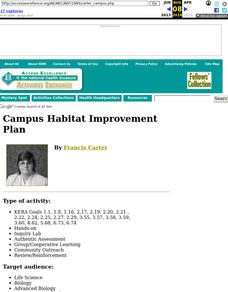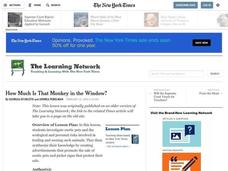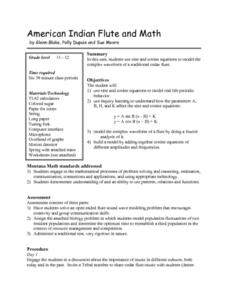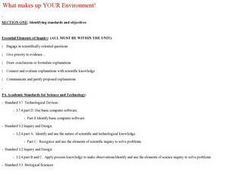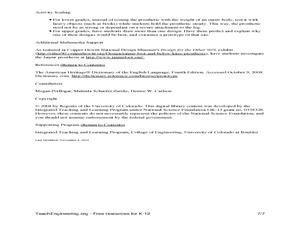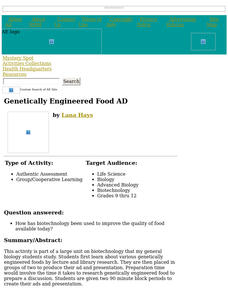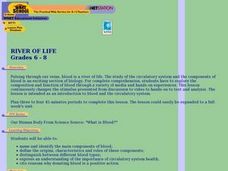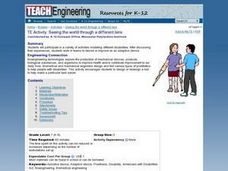Curated OER
Campus Habitat Improvement Plan
Students work to improve a plot of land. They assess the needs of the environment and formulate a plan. They plant trees and gardens, build bird boxes, construct waterholes. etc.
Curated OER
Graze Like a Cow
Students explore how a cow digests the grass they eat. In this science/math lesson, students compare the quality of forage. Additionally, students determine the effects of rangeland health on the production.
Curated OER
Arsenic and Human Health
Ninth graders concentrate on arsenic poisoning as an example of the connections among health, geography, and geology as they develop a persuasive presentation about the dangers of arsenic in the drinking water, targeting a specific...
Curated OER
History and Development of the Microscope
In this microscope worksheet, young scholars review how microscopes work and how early scientists figured out how microscopes could help them with their discoveries. This worksheet has 3 fill in the blank and 7 short answer questions.
Curated OER
Nothing to Sneeze At
Students explore allergic reactions; they then synthesize their knowledge by creating informational pamphlets that help new allergy patients research the nature of allergies.
Curated OER
How Much is That Monkey in the Window?
Students investigate exotic pets and the ecological and personal risks involved in trading and owning such animals. They synthesize their knowledge by creating advertisements that promote the sale of exotic pets and picket signs that...
Curated OER
Ethical Ways to Acquire and Distribute Fish as a Food Source
Students complete a variety of activities as they examine the ethics of acquiring and distributing fish as a food source. They touch on the ethics involved in genetically modified salmon, as well.
Curated OER
Welcome to Love Canal
Students engage in a variety of activities that address the ethical issues surrounding the Love Canal case study.
Curated OER
American Indian Flute and Math
Students investigate the Math behind Musical instruments in this cross-curricular Math lesson on the Native American Flute and waveforms. The lesson can be accomplished in 6 days and includes an extensive materials list for successful...
Curated OER
What makes up YOUR Environment!
Young scholars create their own land or water environment. They make their environment livable for all the different animals they collect to put in it. Students research the types of animals that they can have in their environment, and...
Curated OER
Prosthetic Party
Students examine human anatomy by creating a prosthetic limb. In this medical engineering instructional activity, students view numerous images of prosthetics used in science today and define several medical terms associated with...
Curated OER
Worm Composting
Second graders discuss worm composting. In this decomposition lesson, 2nd graders look at the anatomy of the worm and how it eats food. They have their own worm bin and review what foods can and can not be given to the worms for...
Curated OER
What happens to water before we use it?
Students examine how water is treated prior to becoming available for human consumption. In this water treatment lesson, students conduct an experiment in which they filter water. Students formulate a hypothesis, test, analyze data, and...
Curated OER
The Great MPA Debate
Students study the 'Marine Protected Areas' process. In this ocean lesson students work in groups, conduct research and present it to the class.
Curated OER
Genetics: Integrated with History and Art
Young scholars work cooperatively in pairing chromosomes, created statistical genetic babies using the face lab, constructed a color DNA booklet and demonstrated mitosis in a flip book.
Curated OER
Genetically Engineered Food AD
Students examine various genetically engineered foods by lecture and library research. They are then placed in groups of two to produce their ad and make a presentation on a food they have developed.
Curated OER
River of Life
Students explore the composition and function of blood through a variety of media and hands-on experiences. This lesson is a very good introduction to blood and the circulatory system.
Curated OER
Technology: Biomedical Engineering
Learners participate in activities simulating various disabilities. After discussions, they work in teams to devise or improve on adaptive devices for people with disabilities. They include drawings of the tools they design and explain...
Curated OER
Vertebrate Dioramas
Students are able to describe the development of their chosen form of vertebrate life from the past to the present in a four to six page typed paper. They explain the use of phylogenetic tree. Students use the phylogenetic tree to...
Curated OER
Vertebrate Dioramas
Students describe the development of their chosen form of vertebrate life from the past to the present in a four to six page paper. They explain the use of a phylogenetic tree, and use this to exemplify an organism's evolutionary change...
Curated OER
Boom and Bust
Students investigate commercial fishery. In this fishery lesson, students describe stages in commercial fishery, interpret data and predict when a fisher stock is showing signs of overexploitation.
Curated OER
Geologic Time Scale Analogy
Students examine geologic time to scale. In this geologic time lesson, students create a time-scale metaphor that shows some of the Earth's important events. Students present their metaphor to the class.
Curated OER
Who Dirtied The Water/Clean Water: Is It Drinkable?
Students enter the room, receive a film canister that contains materials that be added to the dirty water bell jar. They record on their data table who or what is doing the adding and the actual substance that has been added to the bell...
Curated OER
The Artemia Hatchery
Students, in groups, develop their hatcheries, working cooperatively in its design and construction. The lessons begin with the introduction to Artemia as a primary food source of many aquaculture species during their larval stages.


